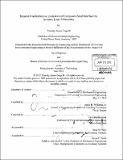Remote nondestructive evaluation of composite-steel interface by acoustic laser vibrometry
Author(s)
Emge, Timothy James, II
DownloadFull printable version (11.10Mb)
Other Contributors
Massachusetts Institute of Technology. Dept. of Civil and Environmental Engineering.
Advisor
Oral Büyüköztürk.
Terms of use
Metadata
Show full item recordAbstract
Composite materials are increasingly being used in both civil and ship structures. In particular, fiber reinforced polymer (FRP) composites are being utilized. FRP materials are most often employed to reinforce aging or damaged portions of civil structures. On naval vessels, FRP materials are incorporated to reduce weight, particularly up high, and to reduce radar cross section, thereby increasing stealth capability. In both cases of FRP use, it is usually in conjunction with some other material, oftentimes steel. It is beneficial when using FRP and steel to adhesively bond them together. When these materials are joined adhesively, the most common failure mode is debonding or delamination at the interface of the adhesive with the steel and composite materials. These defects are often difficult to discern without the aid of some form of nondestructive testing (NDT). Acoustic laser vibrometry is a relatively new method of NDT that shows a lot of promise in analysis of this interface. In this approach, an airborne acoustic wave is utilized to excite the location of the damage underneath the FRP sheets/plates and the target vibration is measured using a laser vibrometer. To study the acoustic laser method, a defect specimen was created from a plate of AL6XN stainless steel and a plate of glass FRP adhesively bonded on their faces with a purposely placed elliptical debonding defect. A number of parameters of the acoustic laser vibrometry system were varied and trends were found. Additionally, grid data was collected from the defect specimen and a defect mapping was created. Theoretical and finite element models were produced and compared to measured results. The close correlation of the results from these three methods validated them all.
Description
Thesis (Nav. E. )--Massachusetts Institute of Technology, Dept. of Mechanical Engineering; and, (S.M.)--Massachusetts Institute of Technology, Dept. of Civil and Environmental Engineering, 2012. Cataloged from PDF version of thesis. Includes bibliographical references (p. 70-73).
Date issued
2012Department
Massachusetts Institute of Technology. Department of Mechanical Engineering; Massachusetts Institute of Technology. Department of Civil and Environmental EngineeringPublisher
Massachusetts Institute of Technology
Keywords
Mechanical Engineering., Civil and Environmental Engineering.